
Copyright 2001-2021 inclusive McGowan Marine Design, Inc.
A 40’ Efficient Cruiser
The as-yet unnamed 40’ (12.2m) Efficient Cruiser uses a hull shape and layout I’ve worked on and tank tested for years, so I was glad when Al Hutchinson of Covey Island Boatbuilders contacted me about working with them and Aspin Kemp and Associates (AKA) to develop a really efficient coastal cruiser/weekender that looked traditional, while propelled by a cutting-edge hybrid system.
General Arrangement
The boat is designed for coastal cruising, as a weekender for a small family, or for a couple with occasional guests. A very functional and good-sized galley - located between the cockpit and saloon - services both spaces equally well. With simplicity in mind, a single very accessible three-piece washroom was chosen over two smaller ones. Its location allows swimmers to easily hop in the shower and rinse off and plumbing is simplified by locating the washroom and galley near each other. The galley includes a four-burner range (propane or electric), refrigerator, sink and good storage.
The cockpit has a transom gate opening onto the swim platform - which is perfect for access to a dock, the tender, or for swimming. The cockpit also has comfortable seating, a drop-leaf table, generous storage below the seats, and a space-saving sliding door to the galley area. Roll-down tent netting sides and stern turns this area into an insect-free lounge, or even a campsite for kids.
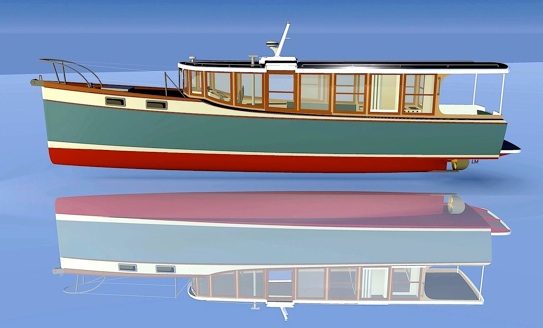
Powering analysis show the design to be very efficient at speeds up to 14 knots, though around 10 knots would be the usual cruising speed. Although narrow, the wide run aft provides plenty of stability and a clean, low-wake run. The slippery lower hull houses the engine, drivetrain, batteries, and tanks.
The modern shape of the lower hull ensures that non-turbulent water arrives at the propeller and rudder for efficient cruising. The Kitchen Rudder - once popular on British and Canadian battleships - increases propeller efficiency (the “nozzle” effect) while improving turning, stopping, reversing, and stern-thrusting.
The topsides, decks, and cabin harken to the golden era of cruising, and don't give any hints about the modern lower hull shape. I drew on the designs of William Atkin and Dave Gerr for the look and feel outside. The interior layout is unique as well: rather than separating outside and inside areas - which usually results in wasted deck space - this cruiser allows passengers to enjoy the outside while in the comfort of a well-lit and ventilated living area. The windows are large and many open, and there is 7' of headroom on the main level.
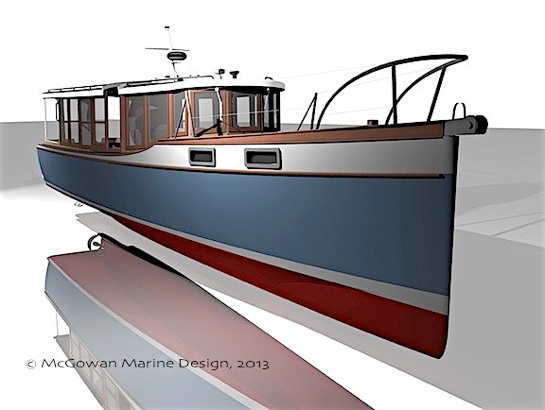
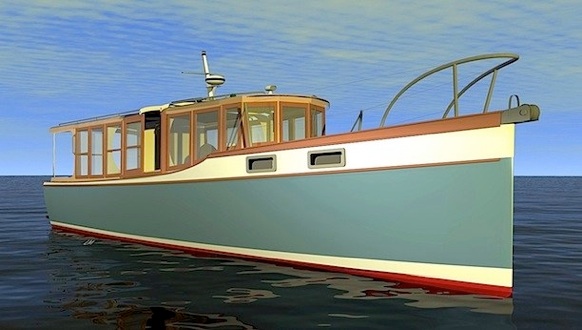
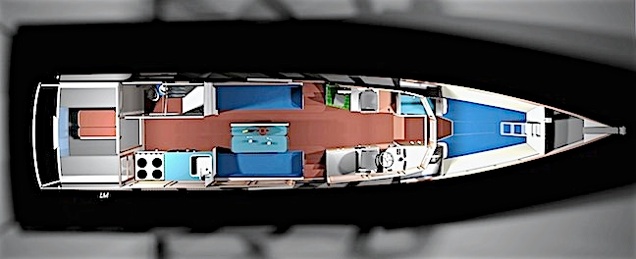
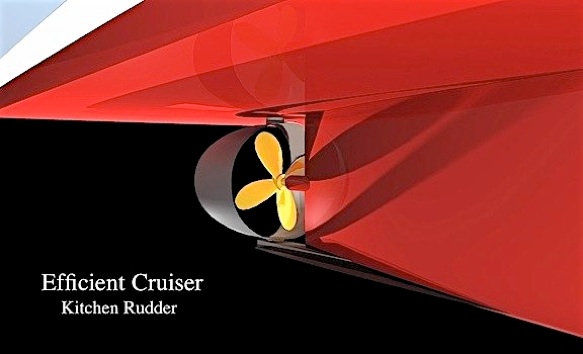
A few weeks later I was really happy to hear Dick Newick, Nigel Irens, and Vincent Loriot Prévost at the 2012 IBEX show in Louisville, Kentucky describe what their ideal efficient powerboat setup would be. Based on their extensive and successful multihull design experiences they each described a similar hull shape: deep sections forward, dead flat run, maybe a chine part-way to all the way back, about a 5:1 beam/length ratio, and a small diesel engine. They were low powered for displacement speeds or speed/length ratios not too much over that. This was just what I was working on but my hull shape - based on a catamaran hull I had tank tested - was a bit different. (see Ghost). It turns out this hull shape is very adaptable to different requirements.
Specifications
LOA
LOD
LWL
Beam
Draft
Displacement
D/L
LWL L/B
Power
42.21’
39.66’
39.35’
8.54’
2.24’ lbs
10,775 lbs
79
5.4:1
60hp Diesel
12.87m
12.09m
12.0m
2.60m
0.68m
4.89t
The raised settees in the saloon provide a unique panoramic view, while each converts to a generous single berth. The large table is perfect for food preparation, dining, laptops, and games.
Forward of the saloon are the companionway steps - to port and starboard, as well as the sliding hatches and doors. They provide excellent access to docks or rafted boats, or for working forward along the wheelhouse sides. Both hatches and doors may be left open in good weather, or a combination of open and closed may be used, depending on the conditions.
Forward of the stairs and to port is a pellet stove in a tiled area - to take the chill off in the shoulder seasons, or on cool days and nights. A chart table with drawer storage below is to starboard. The raised helm is forward of this, and provides excellent visibility all around, even straight back to the cockpit. All controls, monitors, electrical panel, and gauges are easily accessed from here. The co-pilot’s seat to port has an excellent view of things as well.
On the way to the generous vee-berth in the forward cabin there is a hanging locker to starboard and drawers and shelf storage to port. The centre of the vee-berth flips up for easy access to steps - to a swing-out ladder that leads to the big access hatch to the foredeck area.
There is ample storage below the vee-berth, and forward of this is the rope locker.
One change I’d make is to widen the hull by another foot. This increase in beam wouldn’t much affect performance at cruising speeds, and the room would be welcome.
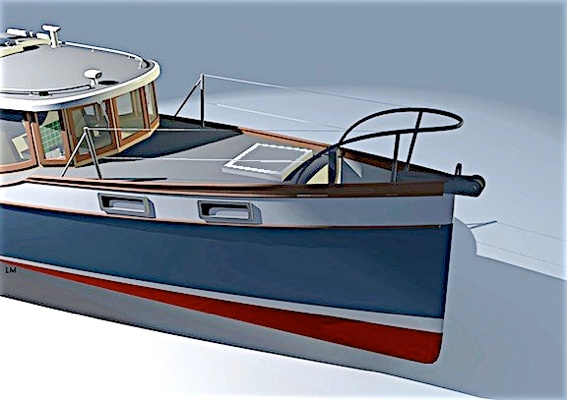
Designed with TouchCad
